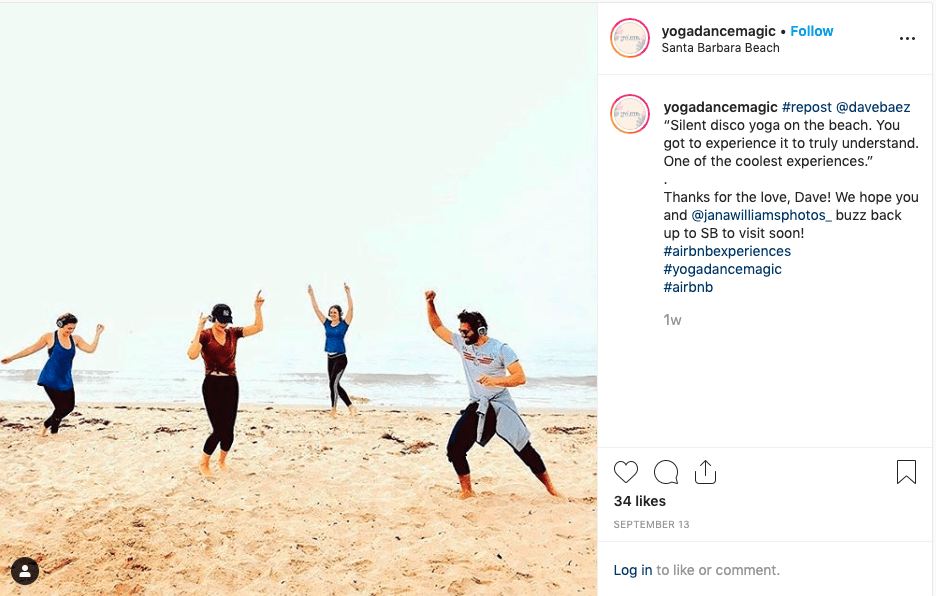Why did you start a yoga business?
When it comes down to it, the likely reason is that you fell in love with the ancient Indian discipline. It’s relaxing and it’s helped you navigate those days where the world seems to be falling on around you. On top of that, it has given you newfound flexibility that lets you flow easier through life. This passion led you to train as an instructor and eventually set up your own business. Driven by an abundance of enthusiasm, your first classes were full, but now growth has slowed down.
Why?
You haven’t invested enough time into branding.
Branding is a process that makes your yoga business distinct and valuable from all the other options on the market. Companies without a strong brand face significant problems like struggling to get by with low prices and relying on volume. In this article, we will discuss why your yoga business needs a yoga a brand and 5 mistakes that are typically made when creating a yoga brand.
Skip ahead to:
Why Your Yoga Businesses Need A Strong Brand
To truly deliver the yoga experience you dreamed of in the early stages of starting up, you need to figure out your yoga branding. If you don’t, your customers will choose one of the many competing companies available. In the US alone, there are more yoga businesses in the USA, according to The Good Body. It is a crowded marketplace! In that environment, you can’t assume your customers lack for other options.
If you have resisted yoga branding in the past, look at the issue from a new perspective. Branding helps your customers and prospects to achieve their goals. Imagine these two conversations and how branding plays a role in the perception of your business.
An Unbranded Conversation About Yoga
Your Customer: The downtown yoga place I go to is excellent. You should come.
Your Customer’s Friend: Hmm… I already have a place. Why should I switch?
Your Customer: Well… It’s cheap?
A Branded Driven Conversation About Yoga
Your Customer: The downtown yoga place I go to is excellent. You should come.
Your Customer’s Friend: Hmm… I already have a place. Why should I switch?
Your Customer: They’re called Relaxed Yoga, and they offer complimentary post-yoga tea to members. It’s my favorite pre-weekend ritual. They have an open house on the first Friday of each month. Want to join me?
Conclusion
In the second example, your customer can make a much more compelling pitch to their friend. In the long run, a business with a strong brand tends to be more sustainable and charge higher prices.
To fine-tune your yoga branding, start making sure to avoid these 5 critical mistakes. Any one of these mistakes can ruin your yoga brand in minutes and make it easy for competitors to lure your customers away.
Mistake #1: Your Yoga Brand Starts with Images and Logos…
When you read the word “branding,” what comes to mind first?
We asked a few first-time yoga entrepreneurs, and most of them said “logos” or “graphics.” That’s a common belief because those assets are the most visible manifestation of a brand. However, starting with a logo as step 1 in building a brand does not make much sense.
If you work with a designer to create a logo or branded graphics, they will ask you all kinds of questions. They want to know what makes your business different. A good designer will ask other questions that go to the heart of your business as well. If you have never thought through your brand, it is going to be tough to answer those questions.
Our advice: avoid starting your yoga branding project by drawing logos, hiring a designer, or creating graphics.
What should you do instead to create a great yoga brand?
Use these five reflection questions:
1) What feelings do I want customers to have after working with us?
2) What problem do you solve for your customers and students? (Hint: aim for something more than “provide yoga instruction”)
3) What part of the yoga industry do you think needs fixing?
4) If your yoga company was a person, what personality would it have?
Taking the time to work through these questions will make a tremendous difference in building a lasting yoga brand.
Mistake #2: You Decide Everybody Is Your Market
This is a tough message, and you need to hear it.
The Top 10 Barriers
Slowing Your Fitness
Business Growth
Discover more Yoga is not for everyone.
Your yoga business is not a good fit for everybody.
You might fight this notion but consider the realities. You can only deliver a certain number of classes each week. That means you should give some thought to whom you want to attract.
Who should be attracted to your yoga brand? That’s the million-dollar question. Let’s take a look at some ways that companies have branded by target market.
Yoga For Round Bodies: Sometimes, people are more comfortable in an environment that reflects who they are. In that spirit, Tiina Veer, a massage professional in Canada, created the “Yoga for Round Bodies” concept to address the need for a safe and inclusive environment for those with larger figures.
Yoga For Special Needs Children: As a parent, it can be tough to find the right activity for a special needs child. Why not try this type of specialized yoga? It’s already offered in India – maybe you can bring this concept to your town.
Yoga For Men: Many yoga participants are women, but men are also interested! Sometimes known as “Bro’ga,” such classes are offered in the Bay of Quinte and other locations.
Prenatal Yoga For Women: Finding pregnancy-friendly exercise can be challenging. That’s why prenatal yoga has become popular. Some yoga businesses have gone all-in on this specialization like New York’s Prenatal Yoga Center. For more insight on how to leverage the prenatal yoga trend, check out our post: “Everything your Fitness Studio Needs to Know about Prenatal Yoga.”
Yoga + Activity Niche: So far, we have looked at yoga specialization by looking directly at different groups of people. There are other ways to position your yoga brand as a distinctive experience. What about combining your yoga class with another fun activity? There are activities aimed at the party crowd like Yoga + Beer. You can also combine yoga with dancing like Yoga Dance Magic. These combinations are an excellent way to promote yoga to people who are tired of conventional classes. These hybrid classes are one of the top fitness trends we forecast for 2020. For more insight about what’s coming next, read our post: “10 Fitness Industry Trends That Could Define 2020.”

There are two several ways to avoid the mistake of marketing your yoga business to everyone. You could build your entire brand around serving specific demographics like the Prenatal Yoga Center in New York. Alternatively, you can create a micro yoga brand by offering a particular branded yoga class (e.g., yoga for women over 50).
Mistake #3: You Suffer from “Me Too” Yoga Branding Syndrome
Whether you’re starting a yoga business from scratch or looking to reinvent your approach, how much should you look at competitors?
Many small businesses and larger firms obsess over their competition’s brand strategy, pricing, and offers. There is some value in monitoring the competition, and it should not be your primary focus when you work on your branding.
Why?
Your yoga brand needs to reflect your priorities, goals, and vision. Copying – intentionally or otherwise – from other companies does not help. On the other hand, reflecting on your business alone in a room without any outside input is tough as well!
If you want to draw branding inspiration from other companies, remember to emphasize your views first. You can do that by reflecting on what you like and dislike in the industry. Use these branding reflection questions to come up with ideas.
- Who was your yoga instructor, and why?
- What frustrates you about other yoga studio locations? (e.g., lack of changing facilities, cleanliness problems, not enough space for each participant)
- What aspects of yoga pricing bother you and why?
- What is your view on hot yoga?
Answering these questions will help you focus on your views and work toward a distinctive yoga brand.
Mistake #4: You Are Always Tinkering with Your Yoga Brand
Do you love to experiment with new ideas every week in your yoga business? If so, you might be hurting your business’s growth without realizing it.
For your yoga brand to become memorable, it needs to be consistent. To use a fast-food example, customers know what to expect when they eat at McDonald’s. You don’t have to be quite as tightly controlled like that, but consistency matters.
In the context branding, once you determine your brand concept, use that same approach throughout your business. To find out if you are consistent with your branding, go through this quick checklist.
- Photos. Do you have a quality photo of yourself and the other yoga instructors at your company? If so, check to make sure they are consistent in general style. When you take new photos, update them everywhere – on your website, on social media, and in your location.
- Service Delivery. The way you deliver services and yoga instruction reflect your brand. For example, if you focus your brand on novice yoga students, your service needs to be consistent with that focus by offering a beginner-friendly approach.
- Reviews. How do customers review your yoga studio online? If your branding is a success, they will use your branded concepts (e.g., “Bro Yoga”). On the other hand, if your brand is relatively generic, you will see generic comments (e.g. “the yoga classes are cheap and fit my schedule.”)
- Social Media and Website. How well are your brand identity and principles reflected in your yoga website? Fortunately, many newer yoga studios and businesses rely on their website for bookings and promotion, so they tend to maintain it accordingly.
- Printed Materials. Think back to the last time you printed cards, flyers, and other materials to promote your yoga business in the community. It might have been several years ago when you were a solo operator. Ask yourself whether those materials reflect your yoga brand today.
When your yoga brand is inconsistent, your customers are likely to become confused. Worse, some may think that you are disorganized in your branding.
Mistake #5: You Create Your Yoga Brand Once and Never Think About It Again
The final yoga mistake is based on a mistaken view of branding. While we said above that your yoga brand should not change continuously, there is a risk in going too far in the other direction. We recommend reviewing your yoga branding each year to see if it reflects your priorities and current goals.
The timing of your annual yoga brand review is up to you. Since this task is a classic “important but not urgent” activity, we recommend putting two hours in your calendar right now. If you cannot remember the last time, you reflected on your brand, commit to doing this review in the next two weeks.
During your annual yoga brand review, consult the following resources:
- 6 Effective Yoga Marketing Tips to Take Your Studio to the Next Level. How will you bring your yoga brand to life and build your business? Review our yoga marketing tips and get moving.
- Building a StoryBrand: Clarify Your Message So Customers Will Listen by Donald Miller. This book is an excellent introduction to branding and how to improve your marketing. The book offers a clear branding process that you can walk through step by step to refresh your brand.
Now ask yourself whether your current yoga brand materials reflect your goals. You may have set new goals in January but failed to carry through those goals into your business.
In Summary
Your yoga brand starts by reflecting your values, goals, and vision. As you change and evolve, your branding should evolve. Next, your yoga marketing needs to respond to the evolving trends and opportunities. In 2017, Apple awarded “Calm” (a meditation app) as the iPhone App of the Year. We’ve also seen books like “Meditation for Fidgety Skeptics: A 10% Happier How-To Book” become successes. There is demand for practices and rituals that help us manage stress safely. These trends are excellent opportunities for some yoga business owners to introduce their approach to more people.
Table of contents















